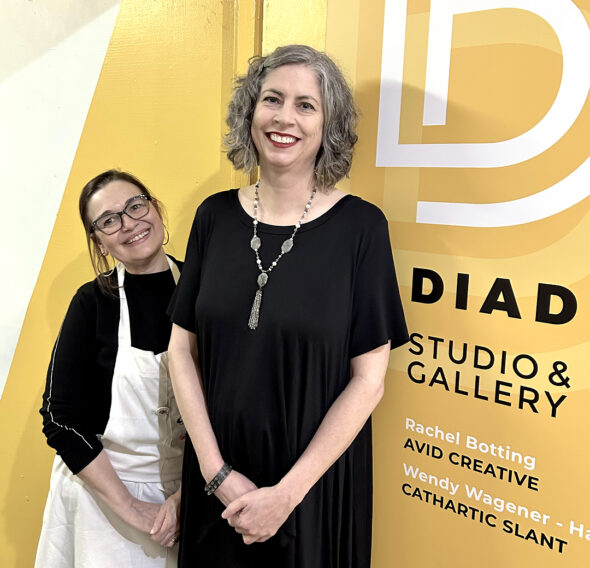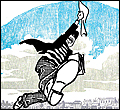
Wendy Wagner-Harris and Rachel Botting of DIAD Studio and Gallery. (Photo by Iden Crockett)
Creating Space | Dayton Poetry Slam welcomes all
- Published: September 26, 2025
CREATING SPACE: This is the second in a profile and interview series from the perspective of News columnist Iden Crockett that aims to highlight people who work in the arts in the Miami Valley, with a focus on those who create space for women, BIPOC and queer creatives.
It was a Friday night when I sat down with artist and gallery owner Wendy Wagner-Harris — the first Friday night in April, to be exact. First Fridays are a monthly event here at the Front Street art complex in downtown Dayton, and DIAD Studio and Gallery was steadily filling with visitors coming to check out the latest exhibition of work by Wagner-Harris and co-owner Rachel Botting. A constant tide of people flooded in and rolled out. Faces of all colors, couples of all types and bodies of all shapes were pointing, chatting and enjoying.
Botting was busy welcoming visitors and pointing out various aspects of the artwork. Wagner-Harris and I were seated at her work bench, and spoke about the space she and Botting created together.
* * *
Wendy Wagner-Harris: Back in 2019, Rachel [Botting] and I were looking to get a studio where we could both make work, and this space became available at Front Street. We signed up in June of 2019. Originally it was just a work space, but then the idea evolved to having a gallery where we could exhibit our own and, potentially, other people’s work.
Iden Crockett: I was going to ask if you had started this place with the intention of dual uses to both create and exhibit work. It sounds like it evolved to that.
Wagner-Harris: We had established our work areas and [saw] what space we would have available for exhibition space, and the fact that Front Street, as it stands now, it’s so great at promoting events.
Crockett: It is so much time and effort to procure a space and then set up a show.
Wagner-Harris: And people will book out years in advance. Trying to find a place to exhibit your work can be a challenge.
Crockett: I want to know about the name of your studio, DIAD.
Wagner-Harris: We were looking for a name that showed the merging of two people, two studio spaces, into one.
* * *
Art greets you immediately upon entering DIAD. The iconic yellow and white DIAD logo covers the front door, mural style. The door itself welcomes you in like a friend putting an arm around your shoulder.
The space is a rectangular, open affair that maintains all of the classic art loft vibes that run through Front Street. The main gallery floor leads directly to the functional, studio half. The inclusive vibe is extended all the way to the windows by the artwork that has spilled out of the main space, covering the wall adjacent to the work area, enveloping the creating with the created, and ensuring that visitors feel welcome entering this more personal area.
Wagner-Harris and Botting are both mixed-media artists. Their long, parallel work tables are piled high with materials. During the interview, several half-finished creations were spread in front of us.
* * *
Crockett: I came through here on a First Friday … and ended up in one of your Collage Week shows. That experience led me to talk with you today, because during that first show, I noticed that there were very many BIPOC people. There were several gender-queer people, several cis females. I’ve noticed that a lot of artists that exhibit here fall into one of these minority categories, and I was curious. Is that something that you guys strive to do? Or have you created a space where those sorts of people come to you?
Wagner-Harris: I think that it’s probably a little bit of both. I think just being in the art community here in Dayton, taking advantage of the opportunities that you have to go out and see other people’s artwork, meet their followers, their friends, their people, it just broadens your world. It broadens your sphere. I guess, when you come really down to it, I feel like I show a lot of the artwork of my friends. And a lot of my friends are artists, and they fall into all kinds of beautiful different categories.
Crockett: Do you think, as an artist yourself, and a gallery owner, is it more difficult to find space to show your work if you belong to a minority group than if, say, you were a cis-gender white man?
Wagner-Harris: The places that come to my mind, I would say, no. I think about Sideshow, which has all these different people. I think of Branch and Bone. I’ve never exhibited there myself, but I know a number of my friends that have, and they are very inclusive as far as the artists they get to exhibit there. I just feel like Dayton in general feels inclusive to me, and I don’t know if that’s just because of who I know.
Crockett: What do you think the impact is, especially to a younger or newer artist, of having a place to exhibit? I think a lot of people that I have met here at the shows I’ve done with you guys were exhibiting their work for the first time. What do you think the impact is for someone like that?
Wagner-Harris: I hope that it gives them confidence to be able to approach another location about showing their work. As a high school teacher, I have over the past couple of years had some of my students as emerging artists on a wall — just having them outside of their own community, and seeing how many other people are out here and getting that kind of exposure, not just for their artwork but for them. To meet other people outside of their own community, I think, is really valuable.
Crockett: When I think of the “establishment art world,” I think of galleries and some of the mainstream magazines. I feel like those places are a little quicker to shut the door on people because they are there to make money. That can be very discouraging to a person, if they are new or marginalized in any way, to sort of be like, “Then there is no place for me.”
Wagner-Harris: For better or worse, I don’t really have any experience with those kinds of venues. A lot of it is just because I only have enough time to do what I’m doing. To really put myself out there, that would have to be my full-time job. Trying to imagine not teaching anymore, and to try to get into that world, I don’t know that that appeals to me right now. I like what I’m doing right now.
Crockett: A lot of artists feel like, “I want to be a professional artist and there is one way to do it.” Having a studio like this proves that there is more than one way to do it. There is more than one focus to have.
Wagner-Harris: I like how you put it that way, because I think that a lot of people in this particular position might always think a little bit, “What if I could get into that big gallery?” But that brings a whole other different bunch of pressures and a different world.
Crockett: I’m so glad that there are these alternative spaces. There’s [this] different style of gallery, or these cafes, or shops, or whatever, where people can take their art to be seen, and they don’t have to pass through the gates. They don’t have to have a master’s degree, or this prestige, or this resume, to be seen. What has been the highlight of your time here, the moment where you were like, “This is what it’s about”?
Wagner-Harris: Oh wow. I think it’s two parts. It’s just being able to sit in here and get lost in my materials and my work. … Then also part [is] seeing the work on the wall and seeing people come in and appreciate it. Whether it’s our work, or a visiting artist, or a group show. Just loving that, that people are having that experience.
Crockett: There is a lot of pressure currently to see the world in dollar signs and to cut funding across the board for anything that doesn’t look like it turns an immediate profit. I think that there are real, long-lasting, deep, intangible benefits that come from fostering a creative community, and they almost never are a straight line to dollars. What do you think the value for a community is from having studios and exhibition places like this?
Wagner-Harris: The diversity of people that come in here, the different ages. In my own personal experiences, having my kids that I’ve taught show up down here in the studio. They come in and they are appreciating all of this that they haven’t seen before. As a teacher, imparting the knowledge, the making, the appreciating, then seeing my students come back down here, or come here for the first time … and knowing that now they are engaged in [the] community as well. I think that’s really gratifying.
Follow Wendy, Rachel and DIAD on Instagram: @catharticslant, @rachy1.0 and @diad937.
If you know a space that you think should be profiled for this series, email Iden at mynameisidenart@gmail.com.
The Yellow Springs News encourages respectful discussion of this article.
You must login to post a comment.
Don't have a login? Register for a free YSNews.com account.















No comments yet for this article.